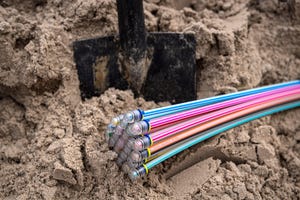CableLabs Makes Symmetrical Multi-Gig Push
Cable R&D group unveils sudden effort to craft 'Full Duplex' DOCSIS spec that would leverage mobile technology to boost upstream speeds.

Conceding that DOCSIS 3.1 won't be the be-all, end-all technology for the cable industry, CableLabs has launched a new drive to craft a fully symmetrical, multi-gigabit version of the new spec.
The proposed new spec, dubbed "Full Duplex DOCSIS 3.1," would enable cable operators to deliver both downstream and upstream speeds of up to 10 Gbit/s over cable's 1GHz hybrid fiber-coaxial (HFC) networks, with the potential for even higher speeds if the spectrum above 1GHz is utilized. That would amount to a huge upstream speed increase over the latest DOCSIS 3.1 spec, which can support downstream speeds as high as 10 Gbit/s but upstream speeds only as high as 2 Gbit/s.
Terming it an "incremental evolution" of the DOCSIS 3.1 spec, CableLabs announced the move to its MSO members behind closed doors at its winter meetings in Orlando late last week. As word began to trickle out about it early this week, the cable R&D organization went public about the effort Tuesday afternoon after initially denying that anything was in the works.
In a fresh blog post on the CableLabs website, Belal Hamzeh, VP, Wireless, R&D, and Dan Rice, SVP, R&D, explained that the proposed spec would apply "emerging techniques from wireless networks to achieve a breakthrough increase in the upstream speeds" for DOCSIS 3.1. Specifically, Full Duplex would leverage Frequency Division Duplexing (FDD), in addition to Time Division Duplexing (TDD), to allow the upstream and downstream traffic to use the same spectrum at the same time, doubling the efficiency of spectrum use. As a result, Hamzeh and Rice write, a DOCSIS 3.1 Full Duplex network "provides the peak speeds and flexibility of TDD solutions, but one-ups both TDD and FDD with double the capacity."
Full Duplex would also be designed to take advantage of "deep fiber" builds by cable operators, splitting fiber nodes and cutting down service groups. With the groups reduced to small, PON-size proportions, cable operators could forego active electronic devices like signal amplifiers and repeaters in their HFC networks and make use of passive signals. Yet cable operators would still be spared the great capital expense of extending fiber lines all the way to the customer premises.
Want to learn more about DOCSIS 3.1, PON and other new cable technologies? Then sign up now for Cable Next-Gen Technologies & Strategies, taking place at the Cable Center in Denver on Thursday, March 10.
Plans call for a special CableLabs team of MSO members and key vendors to work on further validating and developing the technology over the next few months. If all goes well by June, Hamzeh and Rice write, "the project will transition from an innovation effort into an R&D project, open to all interested participants."
As word began to leak out about Full Duplex earlier this week, leading operators around the world hailed the new drive by CableLabs. In Australia, for instance, NBN Co Ltd. lauded the move as "extremely exciting news for nbn and a real game-changing moment in the ultra-fast broadband market."
"We will be working closely with CableLabs to track the development of this technology and are excited about the potential this offers for the 4 million premises that will receive their nbn services via our HFC network," said Dennis Steiger, CTO of NBN Australia, who was in the US meeting with CableLabs to discuss the new technology. "We now have the pathway to deliver these ultra-fast symmetrical speeds to our HFC end-users both very cost effectively and far more conveniently than we could if we had to deliver fiber all the way to their homes."
— Alan Breznick, Cable/Video Practice Leader, Light Reading
About the Author(s)
You May Also Like




_International_Software_Products.jpeg?width=300&auto=webp&quality=80&disable=upscale)







